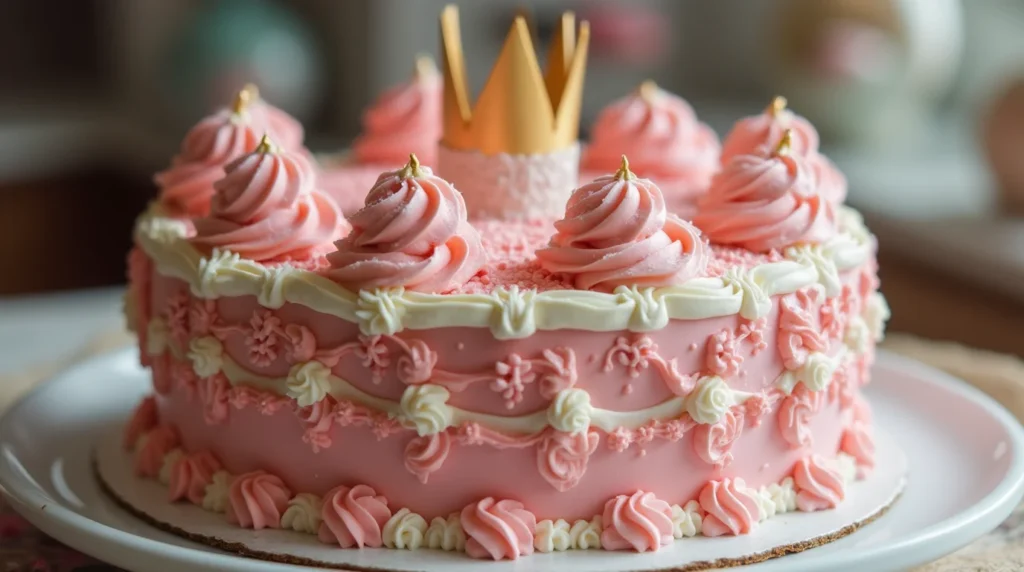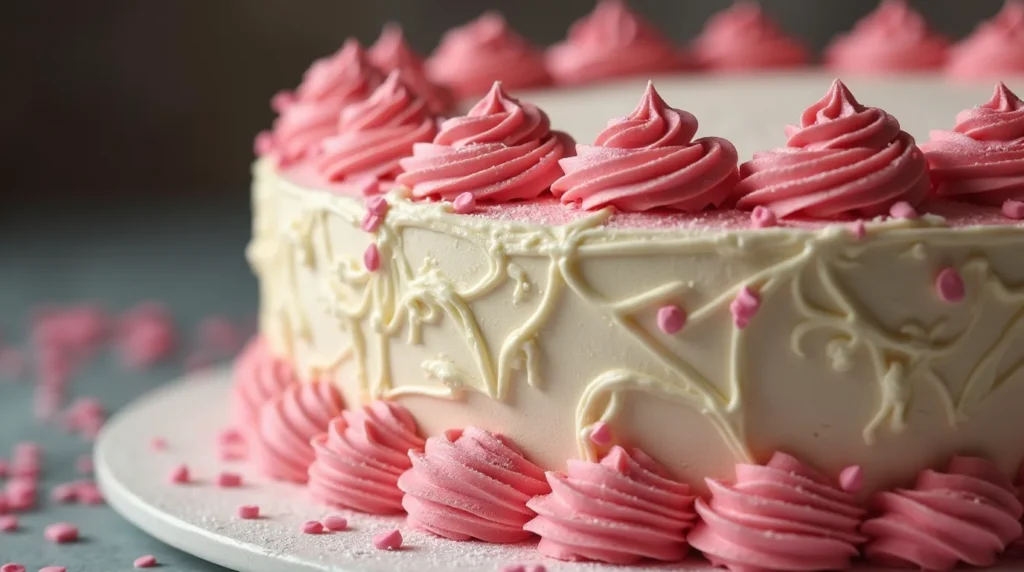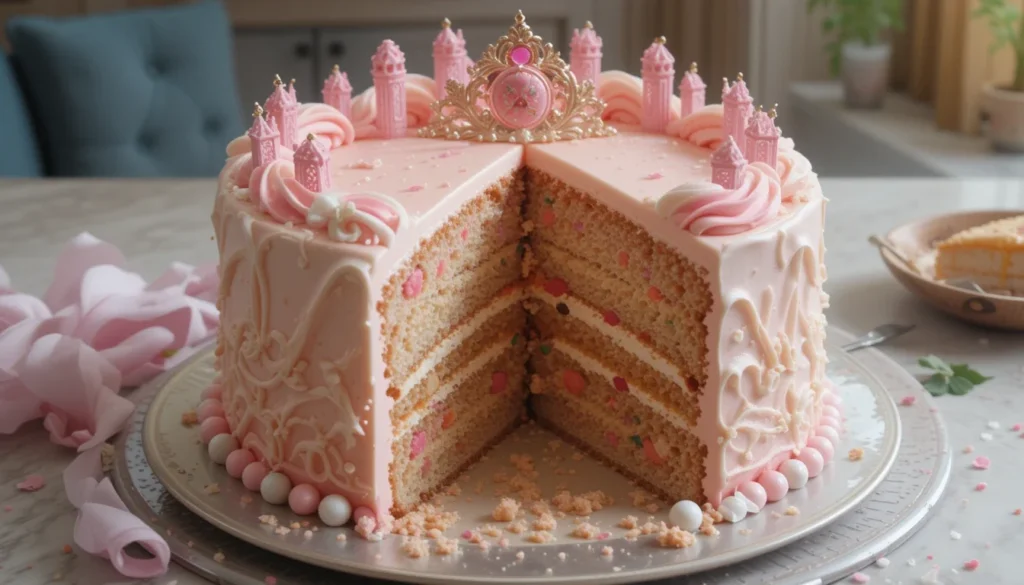Table of Contents
Introduction
Princess Cake, known as Prinsesstårta in Swedish, is one of the most famous desserts from Scandinavia. This elegant cake is characterized by its light sponge layers, rich pastry cream, and a distinctive dome of whipped cream, all encased in a smooth, green marzipan covering. Topped with a delicate pink marzipan rose, it is a treat fit for royalty.
Originally called Grön Tårta (Green Cake), it was later renamed Princess Cake because Swedish princesses loved it. The popularity of this cake has since spread worldwide, and it remains a cherished part of Swedish culture today. Whether served at birthdays, weddings, or special occasions, Princess Cake continues to be a symbol of sophistication and indulgence.
The History of Princess Cake
The origins of Princess Cake date back to the early 20th century. It was created by Jenny Åkerström, a renowned Swedish home economics teacher who taught the three princesses of Sweden. Her cookbook, “Prinsessornas Nya Kokbok,” first published in 1929, featured this dessert, which soon became associated with Swedish royalty.
Even today, the cake is celebrated across Sweden, particularly during “Prinsesstårtans Vecka” (Princess Cake Week), a time when bakeries showcase their best variations of this classic treat. Learn more about its history on Wikipedia.
As the years passed, Princess Cake evolved into a staple of Swedish bakeries. While the original recipe has remained largely unchanged, many chefs and home bakers have experimented with different flavors, fillings, and decorations, adding their unique twist to the traditional delight. Some versions incorporate fruit-flavored marzipan, while others use alternative fillings like lemon curd or vanilla custard instead of raspberry jam.

Traditional Ingredients and Layers
A classic Princess Cake consists of several meticulously crafted layers:
- Sponge Cake – Light, airy, and delicate.
- Pastry Cream – A rich, velvety custard.
- Raspberry Jam – Adds a fruity contrast.
- Whipped Cream – Creates the signature dome shape.
- Marzipan Covering – Traditionally green with a pink rose.
Each layer complements the next, resulting in a perfect balance of flavors and textures. You can find an authentic recipe at King Arthur Baking.
The most striking feature of a Princess Cake is its green marzipan exterior. The marzipan is rolled out thinly and draped over the whipped cream dome, creating a smooth and flawless finish. Achieving this smoothness requires precision, as marzipan can be delicate and prone to tearing. The finishing touch is a dusting of powdered sugar and the signature pink rose, which adds an element of elegance to the cake’s presentation.
How Princess Cake is Made – Step-by-Step Recipe
Ingredients:
- 3 large eggs
- 3/4 cup sugar
- 3/4 cup flour
- 1 tsp baking powder
- 2 cups heavy cream
- 1 cup milk
- 3 tbsp cornstarch
- 1/2 cup raspberry jam
- 1/2 lb marzipan
- Green and pink food coloring
Instructions:
- Bake the Sponge Cake
- Preheat oven to 350°F (175°C).
- Beat eggs and sugar until light and fluffy.
- Gently fold in flour and baking powder.
- Pour into a greased cake pan and bake for 25 minutes.
- Prepare the Pastry Cream
- Heat milk in a saucepan.
- Whisk egg yolks, sugar, and cornstarch.
- Slowly pour hot milk into the mixture while stirring.
- Cook on low heat until thickened.
- Assemble the Cake
- Slice the sponge cake into three layers.
- Spread raspberry jam on the bottom layer.
- Add a layer of pastry cream and place the second sponge layer.
- Cover with whipped cream and shape into a dome.
- Roll out green marzipan and cover the cake.
- Decorate with a pink marzipan rose.

Proper assembly is crucial to achieving the traditional dome shape. The whipped cream must be firm enough to support the marzipan without collapsing, and the cake should be chilled before applying the marzipan to make the process easier. Many bakers also recommend lightly dusting the rolling surface with powdered sugar to prevent the marzipan from sticking.
Variations of Princess Cake Across Scandinavia
While the Swedish Prinsesstårta is the most famous, similar cakes exist in other Nordic countries:
- Norwegian Marsipankake – Uses more marzipan and layers of cream.
- Danish Prinsessekage – Often includes almond sponge.
Discover the Norwegian version, Marsipankake, on Wikipedia.
Modern adaptations of Princess Cake are also becoming popular worldwide. Some versions replace raspberry jam with strawberry preserves or apricot compote. Others experiment with chocolate marzipan, giving the cake a completely different taste and appearance. Vegan and gluten-free alternatives are also emerging, making this classic dessert accessible to more people.
Serving and Storage Tips
- Best Served: Fresh, at room temperature.
- Storage: Can be refrigerated for up to 3 days.
- Pairing Suggestions: Enjoy with Swedish coffee or Elderflower cordial.
To keep the cake fresh, store it in an airtight container in the refrigerator. However, it’s best to consume it within a couple of days, as marzipan can become sticky if left exposed to moisture. If you’re making the cake ahead of time, consider keeping the marzipan separate and applying it just before serving.
frequently asked questions (FAQs) about Princess Cake:
1. What is Princess Cake?
Princess Cake (Prinsesstårta) is a Swedish dessert made with light sponge cake, pastry cream, raspberry jam, whipped cream, and a green marzipan covering. It’s topped with a pink marzipan rose and dusted with powdered sugar.
2. Why is Princess Cake green?
The green color comes from dyed marzipan, which is traditionally used to coat the cake. This distinctive look makes it visually unique and instantly recognizable.
3. What does Princess Cake taste like?
It has a light, creamy, and slightly nutty flavor, with the sweetness of marzipan balancing the tanginess of raspberry jam and the richness of whipped cream and pastry cream.
4. Can I make a gluten-free version of Princess Cake?
Yes! Simply substitute gluten-free flour for the sponge cake and ensure the marzipan and pastry cream ingredients are gluten-free.
5. How long does Princess Cake last?
It is best eaten fresh but can be stored in the refrigerator for up to 3 days in an airtight container. The marzipan layer helps keep the cake moist.
6. Can Princess Cake be frozen?
Yes, but it’s best to freeze the sponge cake layers separately and assemble the cake fresh. Freezing a fully assembled Princess Cake can make the marzipan sticky when thawed.
7. What is the history of Princess Cake?
It was created in the early 20th century by Jenny Åkerström, a Swedish home economics teacher who taught the three Swedish princesses. The cake became associated with royalty due to their love for it.
8. Are there variations of Princess Cake?
Yes! While the Swedish version is the most famous, variations exist in Norway (Marsipankake) and Denmark (Prinsessekage). Some modern versions use different flavors of jam or chocolate marzipan.

9. What is the best way to serve Princess Cake?
It should be served at room temperature for the best texture. It pairs well with Swedish coffee, elderflower cordial, or champagne.
10. Can I make Princess Cake without marzipan?
Yes, but it won’t have the traditional look or taste. Some alternatives include rolled fondant or white chocolate ganache, though marzipan is what gives the cake its signature flavor.
Conclusion
Princess Cake is more than just a dessert; it’s a symbol of Swedish culinary heritage. Whether you’re baking it at home or enjoying a slice at a bakery, this elegant treat is a must-try for anyone who loves European pastries.
For those who enjoy elaborate cake designs, exploring zebra cakes or Barbie cakes could provide inspiration for other creative baking projects. If you’re a fan of citrus flavors, a lemon zest cake can be a delightful contrast to the rich marzipan and custard layers of Princess Cake. Additionally, for a no-bake option, consider trying a no-bake lemon éclair cake for an easy yet elegant dessert.
With its soft sponge cake, creamy custard, and delicate marzipan topping, Princess Cake remains a timeless classic in the world of desserts.

